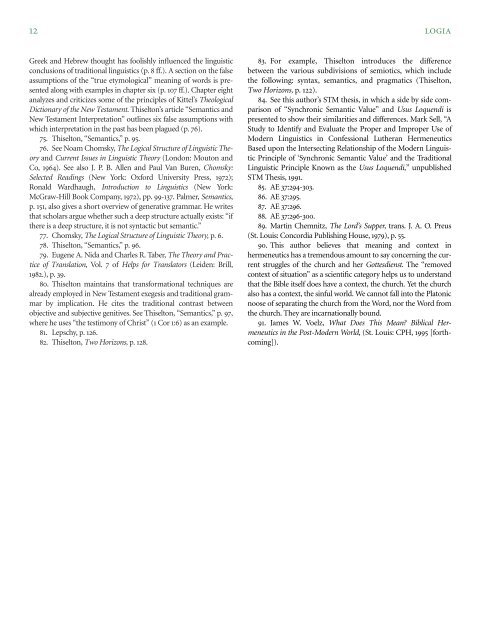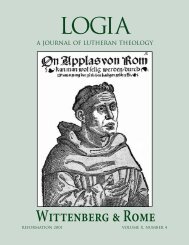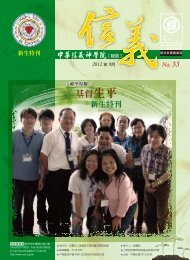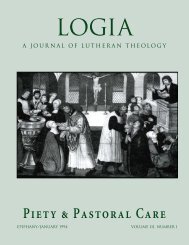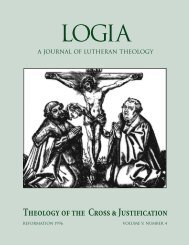12 LOGIAGreek and Hebrew thought has foolishly influenced the linguisticconclusions of traditional linguistics (p. 8 ff.). A section on the falseassumptions of the “true etymological” meaning of words is presentedalong with examples in chapter six (p. 107 ff.). Chapter eightanalyzes and criticizes some of the principles of Kittel’s TheologicalDictionary of the New Testament. Thiselton’s article “Semantics andNew Testament Interpretation” outlines six false assumptions withwhich interpretation in the past has been plagued (p. 76).75. Thiselton, “Semantics,” p. 95.76. See Noam Chomsky, The Logical Structure of Linguistic Theoryand Current Issues in Linguistic Theory (London: Mouton andCo, 1964). See also J. P. B. Allen and Paul Van Buren, Chomsky:Selected Readings (New York: Oxford University Press, 1972);Ronald Wardhaugh, Introduction to Linguistics (New York:McGraw-Hill Book Company, 1972), pp. 99-137. Palmer, Semantics,p. 151, also gives a short overview of generative grammar. He writesthat scholars argue whether such a deep structure actually exists: “ifthere is a deep structure, it is not syntactic but semantic.”77. Chomsky, The Logical Structure of Linguistic Theory, p. 6.78. Thiselton, “Semantics,” p. 96.79. Eugene A. Nida and Charles R. Taber, The Theory and Practiceof Translation, Vol. 7 of Helps for Translators (Leiden: Brill,1982.), p. 39.80. Thiselton maintains that transformational techniques arealready employed in New Testament exegesis and traditional grammarby implication. He cites the traditional contrast betweenobjective and subjective genitives. See Thiselton, “Semantics,” p. 97,where he uses “the testimony of Christ” (1 Cor 1:6) as an example.81. Lepschy, p. 126.82. Thiselton, Two Horizons, p. 128.83. For example, Thiselton introduces the differencebetween the various subdivisions of semiotics, which includethe following: syntax, semantics, and pragmatics (Thiselton,Two Horizons, p. 122).84. See this author’s STM thesis, in which a side by side comparisonof “Synchronic Semantic Value” and Usus Loquendi ispresented to show their similarities and differences. Mark Sell, “AStudy to Identify and Evaluate the Proper and Improper Use ofModern Linguistics in Confessional Lutheran <strong>Hermeneutics</strong>Based upon the Intersecting Relationship of the Modern LinguisticPrinciple of ‘Synchronic Semantic Value’ and the TraditionalLinguistic Principle Known as the Usus Loquendi,” unpublishedSTM Thesis, 1991.85. AE 37:294-303.86. AE 37:295.87. AE 37:296.88. AE 37:296-300.89. Martin Chemnitz, The Lord’s Supper, trans. J. A. O. Preus(St. Louis: Concordia Publishing House, 1979), p. 55.90. This author believes that meaning and context inhermeneutics has a tremendous amount to say concerning the currentstruggles of the church and her Gottesdienst. The “removedcontext of situation” as a scientific category helps us to understandthat the Bible itself does have a context, the church. Yet the churchalso has a context, the sinful world. We cannot fall into the Platonicnoose of separating the church from the Word, nor the Word fromthe church. They are incarnationally bound.91. James W. Voelz, What Does This Mean? Biblical <strong>Hermeneutics</strong>in the Post-Modern World, (St. Louis: CPH, 1995 [forthcoming]).
The Uniqueness of the Christian ScripturesThe Scriptures in the Context of HistoryARNOLD J. KOELPINAsingular uniqueness of the Christian Bible is that it isanchored in history. On the surface this assertion may flyright over our heads. After all, are not the scriptures ofother religions similarly unique? Does not a course in world religionsdemonstrate that ancient Hindu Vedas from the East andthe Book of Mormon in the West exemplify writings that alsoclaim to be anchored in history? Is not the claim for the uniquenessof the Christian Scriptures just another case of Christianchutzpah instilled from its Judeo-Christian past?The questions are valid. They do not merely focus our attentionon the task of comparative religions. They are especiallyimportant for the understanding of a biblical hermeneutic.This presentation does not intend to compare the ChristianScriptures to those of other world religions. Our task is to gain aperspective for a fruitful discussion by showing how the ChristianScriptures relate to the course of human history. By drawing fromthe Scriptures’ own self-understanding, we aim to sharpen ourawareness of the uniqueness of the Christian Scriptures in onerespect: theirunderstanding and use of history.This goal demands that we know how the Christian Scripturesunderstand history. Only then are we able to turn thisinsight around and use history as a tool to understand the Scripturetext. In the interrelation of the understanding and use of historylies the secret of the Christian faith and its testimony to theworld. Why? Because all Christian understanding and study ofhistory is anchored in God himself.THE CHRISTIAN UNDERSTANDING OF HISTORYIn Christian belief God created history “in the beginning”when he created “the heavens and the earth” and all that theycontain (Gn 1). In the widest sense, all history is set in God’stime and space. Time and space are two basic divine dimensionsin which “we live and move and have our being” (Acts17:28). They are, as it were, the box that God made formankind, the crown of his creation, to live in. When timebegan, God created the universe in its length and breadth anddepth. He made its “woodlands, fields and meadows,” its sightsand sounds and smells.ANOLD J. KOELPIN is professor of religion and social studies at MartinLuther College, New Ulm, Minnesota, and is a LOGIA contributing editor.13As elementary as it may sound, people and events operateon the stage of history at certain times and in certain places. Inthe annals of history we keep track of nations and circumstancesthrough the medium of chronology and geography. They contextualizelife, not as happenstances, but as part of God’s goodearth, his creative order. Pegging things chronologically and geographicallyhelps us to sort out happenings from one anotherand to tell their story.It is important to know “time” and “placement.” Abrahamdid not live at the time of Moses. Abraham was a nomad in Palestinebefore the great lawgiver led the nation of Israel back to it.Consequently, the Hebrew patriarch did not live under therestrictions of the Mosaic Law-code given some 430 years later.He lived by faith in God’s universal promise made to him. AndSt. Paul explains the historical significance of the difference inGalatians 3. As in any human testament, Paul writes, the law cannotchange the prior promise. So Moses’ Law served as a necessarycodicil to the Abrahamitic Promise until Christ came.Similarly, it is historically important to know that Mohammeddid not live before Christ (B.C.) but in Arabia some sixhundred years after Christ (A.D.). The difference in time andplace helps to contextualize an understanding of the two religions,both of which claim Abraham as their own. In this way,time and space rescue our understanding from pure abstraction.When we tell the story, they give present reality to whathappened in the past. Time and space help us to store andretrieve the story from the memory bank of history for ourlearning and edification.The LORD of HistoryNow all this which is history and life—because history islife—will not make sense to us unless we understand that Godcontrols history. And God’s lordship over life only makes sensewhen we face the secret of history itself.Mastering HistoryTo our human eye, history is nonsense. As Henry Fordunabashedly stated on the witness stand, “History is bunk.”History perplexes us because it is inexact, illogical, irrational,and disturbs our innate sense of perfection—the way thingsought to be. As a result we grow frustrated precisely because wecan neither master nor control history. Time just appears to


